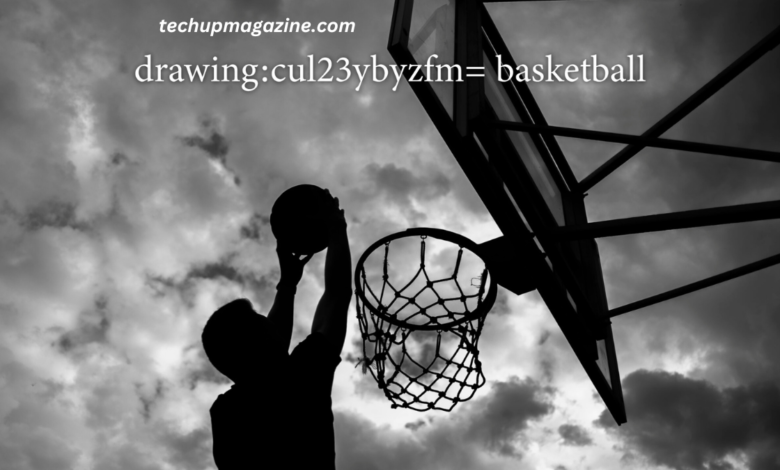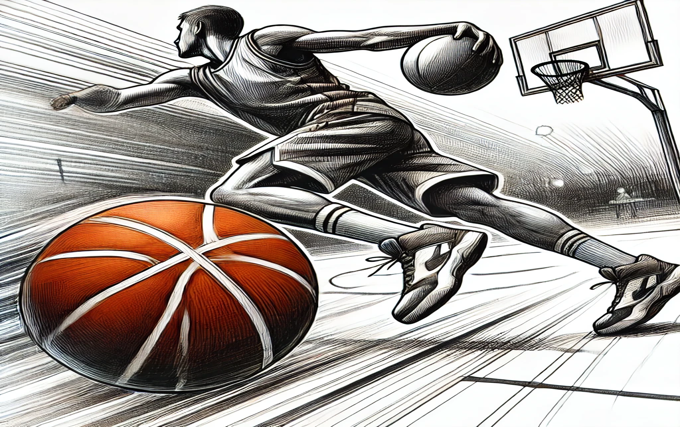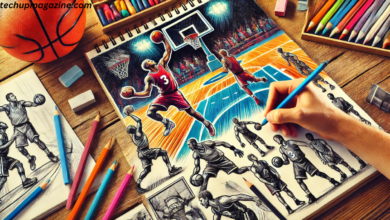Mastering drawing:cul23ybyzfm= basketball: A Step-by-Step Guide

drawing:cul23ybyzfm= basketball has always been a captivating sport for many people, not just for those who love to play but also for those who enjoy sketching the dynamic movements and exciting action scenes that come with it. If you’ve ever wanted to learn how to draw drawing:cul23ybyzfm= basketball-related scenes, whether it’s a ball in action, a player making a slam dunk, or a simple basketball court, this guide will help you develop the necessary skills. We’ll break down every element to make your drawings come to life and improve your drawing:cul23ybyzfm= basketball techniques.
In this article, we’ll cover everything you need to know about drawing:cul23ybyzfm= basketball. From understanding the basic shapes to capturing the fluidity of movement, you’ll learn all the tips and tricks to perfect your drawings. So, grab your pencils and sketchpads, and let’s dive into this exciting art form!
Understanding the Basics of drawing:cul23ybyzfm= basketball

Before diving into more complex drawing:cul23ybyzfm= basketball, it’s crucial to understand the basic shapes and forms that make up the sport. Basketball is a visually dynamic game, and capturing its essence requires a solid understanding of its components.
When you look at a drawing:cul23ybyzfm= basketball itself, it’s essentially a sphere. The sphere can be tricky to draw if you don’t break it down. Begin by sketching a circle and adding guidelines to make it appear three-dimensional. The key to drawing:cul23ybyzfm= basketball a realistic basketball lies in the details: the texture, lines, and shadowing. Understanding how light falls on a sphere will allow you to create depth and realism in your drawing.
Next, think about the court. The court’s straight lines and flat planes contrast with the drawing:cul23ybyzfm= basketball ounded form, so balancing both is essential. Understanding basic perspective drawing will help you create a more accurate representation of the basketball court. Focus on how the lines on the court converge toward vanishing points, giving your drawing a realistic three-dimensional feel.
Drawing a drawing:cul23ybyzfm= basketball Player: From Sketch to Final Detail
Once you’re comfortable drawing individual elements, it’s time to take on the challenge of drawing a basketball player. drawing:cul23ybyzfm= basketball players in action make for dynamic and energetic subjects to sketch, but they can also be tricky if you’re unfamiliar with human anatomy and motion.
Start by sketching the player’s body using simple shapes. Break the body down into basic forms, such as ovals and rectangles, for the torso, limbs, and head. This approach will help you get the proportions right before diving into the details. Pay special attention to the player’s posture—drawing:cul23ybyzfm= basketball players are often in motion, so capturing a sense of movement is key.
As you move from the rough sketch to refining the details, focus on the player’s muscles, the position of the arms and legs, and the facial expression, which should convey effort, focus, or excitement. The player’s jersey, shorts, and sneakers add the final touch, so make sure to incorporate realistic folds and shading to make the clothing pop. Don’t forget to include the drawing:cul23ybyzfm= basketball in the player’s hand, using the techniques you’ve already learned for drawing the ball.
Capturing Movement in drawing:cul23ybyzfm= basketball
Movement is a defining aspect of drawing:cul23ybyzfm= basketball, and capturing it in a static drawing is both a challenge and an art form. One of the best ways to depict movement is through dynamic poses and gesture drawing. Gesture drawing is a technique where you quickly sketch the overall form and movement of a subject without focusing too much on the details.
In drawing:cul23ybyzfm= basketball, gesture lines can show the direction of motion. Think about the path of the ball, the arc of a jump shot, or the motion of a player’s arm as they dribble or shoot. These lines guide the viewer’s eye and make the drawing feel alive. You can also emphasize movement by drawing the player’s hair or clothing in motion, giving the impression that they are running or jumping.
Additionally, using motion lines can be effective for suggesting the speed of the ball or the movement of a player. For example, if you’re drawing a dunk, you can show the force and height of the jump by extending the player’s limbs and drawing motion lines that lead the viewer’s eye toward the hoop.
Shading and Adding Depth to Your drawing:cul23ybyzfm= basketball
Shading is a critical part of any drawing, and it’s especially important when drawing:cul23ybyzfm= basketball-related images. Without proper shading, your drawing can appear flat and unrealistic. To add depth and dimension to your drawing:cul23ybyzfm= basketball, pay close attention to the light source in your scene.
Start by identifying where the light is coming from. This will help you determine where to place your shadows and highlights. For instance, if you’re drawing a player on a court, think about the overhead lights in a stadium. The top of the drawing:cul23ybyzfm= basketball will be illuminated, while the bottom will have more shadows. Similarly, the player’s face, jersey, and legs will have different areas of shading depending on the position of the light.
Layering your shading and gradually building up the darker areas will give your drawing a more realistic look. Use cross-hatching, stippling, or smooth shading techniques to add texture and depth. Don’t be afraid to use references—studying photographs of drawing:cul23ybyzfm= basketball games can give you a better understanding of how shadows and highlights work in real life.
Perfecting the Details: Adding Texture and Features
Once the basics of your drawing:cul23ybyzfm= basketball are in place, you can focus on the finer details. One of the first things to consider is texture. Whether you’re drawing a basketball, a court, or a player’s jersey, texture plays a significant role in making your drawing:cul23ybyzfm= basketball more realistic.
For the basketball itself, use short, curved lines to suggest the rough, pebbled texture of the ball’s surface. Don’t forget the seams of the basketball, which are crucial for defining its shape and making it recognizable. These seams should follow the curvature of the ball, helping to reinforce its three-dimensional form.
When it comes to the player’s uniform, think about how the fabric folds and stretches with movement. Adding subtle wrinkles to the jersey and shorts will make your drawing more lifelike. For the court, use straight, clean lines to draw the hardwood floor, but add some texture to suggest the grain of the wood. Little details like this go a long way in elevating the quality of your drawing.
The Importance of Perspective in Basketball Drawings
Perspective is another crucial aspect to consider when drawing basketball scenes. Whether you’re drawing a player shooting a hoop, or a close-up of a basketball court, understanding perspective will help your drawing look more realistic and visually engaging.
To start, think about the angle from which you’re viewing the scene. Are you looking straight at the player, or are you seeing them from a bird’s-eye view? Use vanishing points and horizon lines to guide your drawing and ensure that the perspective is consistent. For instance, if you’re drawing a basketball hoop, the circular rim will appear more oval as it moves away from your eye level.
Perspective also plays a key role when drawing the court. The lines of the basketball court converge toward the vanishing point, creating a sense of depth and distance. Practicing perspective drawing can greatly improve the overall realism and appeal of your basketball artwork.
Incorporating Background Elements to Complete the Scene
A great basketball drawing isn’t just about the player or the ball—it’s also about the environment they’re in. Adding background elements like the basketball court, bleachers, or even an audience can bring your drawing to life and tell a more complete story.
When adding background elements, it’s important not to overwhelm the main subject. Keep the background simple and less detailed to maintain the focus on the player or ball. For example, you can suggest the shape of a basketball hoop and backboard without drawing every bolt and net strand. Similarly, drawing the outlines of fans in the stands can add atmosphere without distracting from the main action.
Think about the setting—are you drawing an outdoor basketball game or an indoor stadium? Each setting will have different lighting and background elements. For outdoor games, you might want to include elements like a chain-link fence or streetlights, while indoor games could feature banners, lights, and even shadows cast by players on the polished floor.
Practicing Different Styles: Realistic vs. Cartoon Basketball Drawings
As you gain confidence in your basketball drawing skills, you might want to experiment with different styles. Two popular styles for drawing basketball scenes are realistic and cartoonish. Each style has its unique appeal and allows you to express different aspects of the sport.
In realistic basketball drawings, the goal is to make the image as lifelike as possible. This means paying close attention to proportions, shading, and details like muscles, clothing folds, and facial expressions. Realistic drawings require more time and patience but can result in stunning, professional-quality artwork.
On the other hand, cartoon basketball drawings are often more exaggerated and playful. You can have fun with proportions, such as drawing oversized heads or exaggerated movements to emphasize action and emotion. This style is great for capturing the fun and excitement of basketball in a more lighthearted way.
Developing Your Basketball Drawing Techniques
As with any art form, developing your style and techniques takes time and practice. The more you draw, the more you’ll refine your basketball drawings and discover what works best for you. Don’t be afraid to experiment with different tools, such as graphite pencils, colored pencils, or even digital drawing software, to see which medium you enjoy the most.
It can also be helpful to study the work of other artists who specialize in sports drawings. Look at how they handle proportions, movement, and shading, and try incorporating some of their techniques into your work. Over time, you’ll develop your unique approach to drawing basketball scenes.
Most importantly, have fun with the process. Drawing is a creative outlet, and while there’s always room for improvement, it’s important to enjoy the journey. Each sketch you complete is a step closer to mastering the art of drawing basketball.
Conclusion: Mastering Basketball Drawing with Practice and Passion
Drawing basketball scenes, whether it’s a simple ball or a full-fledged game in action, is a rewarding and exciting challenge for any artist. With the right approach and a bit of practice, you can create dynamic, realistic, and captivating drawings that capture the spirit of the game.
By breaking down each element—from the basketball to the players to the court—you can build your drawing step by step. Pay attention to details like texture, shading, and perspective to add depth and realism to your work. And don’t be afraid to try different styles and techniques to find what suits you best.
In the end, the key to improving your basketball drawing skills is practice. The more you draw, the better you’ll become at capturing the excitement and energy of basketball on paper. So, grab your sketchbook, and start drawing!


